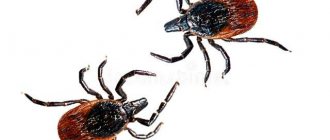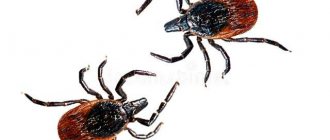Veterinarians are often faced with the fact that owners do not know how to remove a tick from a cat, and are forced to eliminate mistakes, which turns into a serious problem for the animal. For some reason, there are a lot of wrong ways among people to get a bloodsucker, despite the negative experience. Therefore, it would be useful to remind you how to remove a tick according to the rules and how not to do this.
Ixodid and Argas parasites dig into the cat's delicate skin to suck blood. The former have a hard shell along the back in males, and in females only in the area of the head. The latter have soft integuments unprotected by the shield. Both species in a hungry state are barely noticeable in the thickness of the fur; we begin to see them when they have already managed to insert the head under the skin, swell in size, and are saturated with blood. Usually in this enlarged state we stretch them out.
Argasid and ixodid ticks
How to detect a tick
A parasite that has not yet become attached can be found by carefully examining and stroking the cat. The suckers are sometimes more difficult to find. Ticks prefer to attach themselves to animals in areas with the thinnest skin:
- ears;
- eyelids;
- lips;
- groin area;
- anal hole.
But ticks can also appear on the cat's neck or back. The easiest way to find parasites in thick fur is by scratching the cat thoroughly.
Important!
Do not stroke the fur, but scratch against the grain. Even a still hungry, but already attached tick under your fingers feels like a hard, mobile tubercle. Having discovered such a tubercle, you need to disassemble the fur and make sure that there is a parasite there. Sometimes an old sore that has begun to peel away from the skin can be mistaken for a tick. On the stomach, the main thing is not to confuse ticks with nipples, which are found not only in cats, but also in cats.
What mistakes should you not do?
Due to possible infection, all procedures that involve contact with insects must be carried out only with gloves. If there are none, you can wrap your fingers with a bandage or any cloth.
Everyone is familiar with the method when an insect is doused with oil, kerosene or other oily liquid. It is believed that the oily liquid will block the air supply, the tick will suffocate and can be easily removed. This method is very dangerous for the animal and should not be used.
The fact is that the parasite can indeed suffocate and die, but you also need to be aware of possible complications. When he doesn’t have enough air, he will go deeper into the wound even further. In addition, in a stressful situation, he will secrete a large amount of saliva, which contains the infection. Therefore, in this case, we, on the contrary, expose the cat to greater danger.
Do not make sudden movements, do not pull, do not jerk the insect. If you tear it out, fragments will remain in the wound. This is quite dangerous, because if they are not removed, inflammation and rot will develop, which leads to serious consequences.
You cannot crush them, because the liquid that is in their digestive system, just like saliva, contains infection. Contact with human or animal skin can lead to infection.
Preventive measures
It is always better to prevent a situation than to look for solutions later. To do this, you need to be careful about protecting your cat. You can purchase a spray or collar at any pet store or veterinary pharmacy; they will protect your pet from insect attacks. You can consult your doctor before purchasing.
In order to avoid complications, you should take vaccination responsibly, that is, do all vaccinations in a timely manner. This attitude of the owner towards his animal will protect him from sad consequences. And even with a tick bite, from which no one is protected, the risks of infection are reduced to zero.
How to properly remove a tick from a cat
After identifying the bloodsucker, you can begin to remove it:
- take the cat more comfortably;
- take a closer look at the tick;
- lubricate scratched hands with brilliant green;
- put the cat in a carrier and take it to the veterinary hospital.
Most cats really, at any attempt to manipulate them, begin to fight for their lives as if they know for sure that an order has been received for a hat made from their skin.
But there are ways to remove ticks from a cat at home. If the cat really does not like such manipulations, it can be immobilized by driving it into the sleeve of a jacket so that its head sticks out of the sleeve. After this, all manipulations with the head and in the tail area can be carried out quite calmly.
On a note!
Veterinary clinics have a special “sleeve” that allows you to immobilize a cat and allows access to any part of the animal’s body, depending on the procedures being performed.
Seizure procedure
When a tick is found on an animal, remember that you should not pull it or try to simply unhook it; such actions can lead to complications.
There are rules that must be followed when carrying out the procedure at home:
- Be sure to wear rubber gloves, since the insect may be infected, which is dangerous for the person himself.
- When removing the parasite, the animal should be calm, not twitch or try to escape. Therefore, calm the cat down, give him a treat and make him comfortable. In this case, no one's help would be superfluous.
- When removing, you should not make sudden movements, pull or crush the insect too much.
- When removing, the method of twisting the parasite is used, which is the safest method.
- Before the procedure, be sure to disinfect your hands, the bite site and the instrument that will be used for removal.
Prevention of bites
Cats that live and walk near the forest (for example, in the country) are at risk. To protect them, there are numerous antiparasitic agents sold in veterinary pharmacies. They are designed to repel insects and ticks. Here are the suitable options:
- Sprays and drops on the withers. The most effective, but are toxic and act for a short period of time. Animals should not be allowed to lick them from their fur.
- Collars. Thin rubber straps are impregnated with a special compound. Less toxic, but due to prolonged contact with skin, allergic reactions or irritation may occur. It is better to wear them only when walking and take them off at home.
Any owner wants his pet to be healthy. This means that in the warm season you need to pay increased attention to the cat’s safety and use preventative agents against ticks.
Signs of a bite and why it is dangerous
Blood-sucking insects of the parasitic type are very leisurely; they know that as soon as contact is found with the carrier, the percentage that they will not be able to bite is negligible. Protective coloring and small size make the pest almost invisible on dark and colorful clothing. From the moment of preparation to direct attachment to the skin, it can take about 20 minutes.
At the stage of blood sucking, anticoagulants enter the host tissue, preventing the process of blood clotting and the parasite can feed for a long time. They act like a pain reliever and the person does not feel discomfort. Removing a tick at the initial stage, before the bite, is possible with care and a certain amount of luck. Even while the ectoparasite is feeding, it can only be noticed visually upon careful examination.
Only when digestive enzymes of saliva are injected into the wound and partial dissolution of the surrounding tissue begins, local inflammation develops, itching, a burning sensation appears, and the temperature may rise. Externally, this is expressed in redness, swelling, and compaction, which can be easily felt with your fingers.
The danger lies not in the bite itself, but in the saliva of the pest, along with which the pathogens of Lyme disease and tick-borne encephalitis can penetrate. They are severe and can lead to disability. The most dangerous are ixodid forest ticks and the meadow variety.
How to properly remove a tick
A tick on a cat Do not give in to advice to spray an arachnid that has already attached itself with a flea remedy.
The bloodsucker will die. But not at once. And before death, it will release the contents of the intestines into the blood along with all the infectious agents present in the insides. The dead parasite's proboscis will remain in the animal's skin and will break off when trying to remove the corpse. It is also bad advice to lubricate the bloodsucker with oil/nail polish/acetone/gasoline and other household chemicals. The arthropod will live for another day, suffer and infect its victim with viruses.
Cats have a smaller arsenal of arthropod removal products than humans. But the same tools are used:
- industrial;
- syringe;
- tweezers;
- thread.
Industrial devices include special devices that allow you to remove a tick without squeezing its body. They may look like a mini nail puller or a special loop of thin wire that retracts into a handle holder.
The device is carefully placed under the tick and unscrewed like a screw. To turn the parasite out, it is twisted counterclockwise.
Important!
Under no circumstances should you rudely tear out an arachnid. In this case, it is easy to tear off the head, which will remain in the skin.
In the absence of special devices, you can rid the animal of the parasite using tweezers. This is not a very desirable option, since unscrewing a tick with tweezers without squeezing the arachnid’s body is a difficult task.
Tweezers
The tweezers are brought as close to the skin as possible and the head of the ixodus is clamped under the body. Then remove it by also unscrewing it counterclockwise.
Thread
A loop of thread is placed over the head of the arthropod, it is tightened and the parasite is removed, gently swinging it from side to side. With this method, the arachnid's head often comes off.
Extraction Methods
For safe removal, tweezers or thread are most often used. Some people remove the parasite with their hands, but this method is not recommended by doctors. In this case, you need to understand how the parasite feeds and how it stays on the body of its victim. As stated earlier, it cuts the skin and penetrates under the skin. There it is sucked by the proboscis, which has microscopic serrations, thanks to which it is held. Along with the proboscis, the head of the tick also penetrates.
If you pull the abdomen, this will cause the insect to rupture and you will not be able to get it out. The head and proboscis will remain in the wound, which will also need to be removed, and in some cases surgical assistance may be required.
For the procedure to be safe, it is necessary to understand how to hold the insect during removal. To do this, if you use tweezers, you need to grab it as close to the skin as possible so that you can capture not only the body, but also the head.
Next, we carry out the following steps: we need to rotate the parasite, which will allow us to unhook it in the middle of the wound. When scrolling, you need to lightly pull it up. As soon as it unhooks in the middle of the wound, it will immediately slide out of it.
Once it is removed, the tick must be destroyed and the wound inspected to see if there are any insect fragments left. Next, disinfect, you can use brilliant green, iodine, alcohol.
Removal at home: step-by-step instructions
Knowing how to remove a tick from a cat, you can carry out the manipulation with a minimum of discomfort for your pet.
Recommendations to use vegetable oil, dripping it onto the embedded parasite, are incorrect, since they extremely rarely lead to a positive result and take too much time, during which the tick’s saliva continues to enter the animal’s body.
The tick must be removed immediately after detection and the matter cannot be put off until a trip to the veterinary clinic. This reduces the risk of your cat contracting diseases.
You can remove the parasite using 3 devices. It is optimal to have special lasso handles or tick twisters, but if they are not available, tweezers will do. To ensure that the tick's head does not remain in the skin, it must be pulled out carefully.
A special veterinary lasso is a plastic stick with a tightening loop at the end. The principle of use is as follows:
- the lasso is thrown over the parasite extremely close to the victim’s skin and, after pulling it up, it is fixed;
- Having brought the device into a vertical position, it is turned clockwise, unscrewing the attached parasite.
It is not enough to have a tick-twister - you also need to know how to properly remove a tick using this tool. It looks like a curved stick, one of the ends of which has a slot (similar to a small nail puller). The device makes it easy to pull out even a deeply embedded tick without tearing it into two parts. Manipulations must be carried out in the following sequence:
- a tick-twister on the skin is placed under the head of the tick;
- then pull it out with rotating movements directed upward.
Tweezers are used as a last resort. It often crushes the parasite rather than removing it completely. The remaining head has to be pulled out separately at the veterinary clinic to prevent suppuration. The sequence of actions is as follows:
- Use tweezers to clamp the tick tightly, but not too tightly, so as not to damage its body;
- then the bloodsucker is twisted out. The parasite can only be removed using rotational movements. It is strictly forbidden to pull it out, as otherwise the tick will leave a detached head in the skin. After the death of the bloodsucker, saliva from its head continues to be released for some time, poisoning the victim’s body. Also, a foreign object in the skin causes a purulent process, which is dangerous with serious consequences.
The best solution if you find a tick is a trip to the veterinarian. An experienced specialist will be able to quickly and efficiently remove the parasite, send its body for testing and prevent possible diseases of the animal.
If you still decide to remove the tick yourself, this can be done at home using several methods.
We suggest you read: Treating an area for ticks in Chekhov
There are several options for removing the parasite:
- Using thread. Take a coarse thread and make a loop out of it, then wrap it around the tick’s body as close to the animal’s body as possible. You need to squeeze the thread and carefully unscrew the tick by turning it counterclockwise.
- Special hook. In pet stores you can purchase special hooks designed to remove pests. Outwardly, it looks like a curved fork with 2 prongs. The tick needs to be secured between them, then also begin to unscrew.
- Removal with tweezers. Thanks to its convenient shape, the tweezers allow you to grab the animal as close to the trunk as possible. You need to pinch it and then pull it out of the skin with rotational movements.
What is the most effective way to remove ticks from a cat? Using a hook gives good results even for beginners, thanks to the well-thought-out shape of this tool, but not everyone may have such an item in their household, so after using it, tweezers will be the most convenient way to remove it.
Previously, we listed the main methods of removal, each of which is based on the same principle - grab the pest as close to the cat’s body as possible and reach it with rotational movements. Using the example of removal with tweezers, let’s take a closer look at how to remove a tick from a cat:
- Preparation. Take the tool, calm the animal and secure it so that it cannot escape during removal. Be sure to wear protective gloves to prevent infection from coming into contact with a tick.
- Take tweezers and grab them near the head, as close as possible to the point of penetration into the skin. Under no circumstances grab this parasite by the body!
- Using gentle rotational movements, begin to twist the parasite out of the body. Usually after three turns you can remove the tick.
- Be sure to wipe the bite area with an antiseptic. Monitor your pet's condition for several weeks after the bite. If you notice alarming symptoms, take your cat to the vet immediately.
- The removed tick should be burned or placed in a container with alcohol. In the second case, you can also take him to the laboratory and find out whether he was a carrier of infections.
What not to do:
- On the Internet you can find a lot of advice that the tick needs to be lubricated with alcohol, oil, and sometimes gasoline before being pulled out. Experienced veterinarians do not recommend doing this. The parasite will definitely begin to experience discomfort from this, but in addition to weakening its grip, this will lead to increased salivation, which increases the chances of infection.
- Do not crush ticks on your cat's body.
- Pick out the tick with a needle or simply pull it out with your fingers.
If you were unable to remove the tick completely and its proboscis broke off, the remaining part of the body must be carefully removed from the body using the same tweezers or a pin. Be sure to wipe the tools with alcohol.
Now you know how to remove a tick from a cat and can perform this operation yourself!
Now you know how to remove a tick from a cat. But after removing the parasite, do not forget to additionally treat the bite site with an antiseptic. Carefully monitor your pet’s condition for several days, check to see if swelling has appeared at the site of the removed tick, or if there is a rash on the skin. If there is a reason, consult a doctor, not forgetting to tell him about the tick you removed. And follow the recommendations exactly when giving your cat the prescribed medication.
Ears should be cleaned regularly with cotton swabs containing hydrogen peroxide.
Preliminary preparation
First, prepare the necessary tools. If you often encounter this problem, I recommend purchasing a tick-twister - this is a special tool for removing ticks, sold in pet stores. When a tick-twister is not at hand, regular tweezers will do.
It is highly not recommended to carry out manipulations with bare hands. There is a high probability that you will miscalculate the force and crush the parasite, and part of its body will remain under the cat’s skin. This is fraught with further infection and penetration of infection.
You will need disposable gloves, a container for the removed tick (preferably with alcohol), and wound-healing ointment.
The tick is torn
A tick on a cat If the parasite is not carefully removed using tweezers or thread, the head often remains in the animal's skin. It looks like a black dot if the cat's skin is white. If the skin is black, it is impossible to see the proboscis. If the tick's head remains in the cat's body, there are 2 possible options:
- wait until it comes out on its own;
- remove with a needle.
In the first case, usually no complications occur. Sometimes, in place of the proboscis remaining in the skin, a hard tubercle appears, which disappears on its own after some time.
In the second case, to remove the head of a tick from a cat, take an ordinary disinfected needle and pick it out like a splinter.
Important!
The cat will definitely not like this manipulation.
Danger from tick bites
A tick on a cat requires immediate removal, as its bite can cause serious illness. Ticks are the causative agents of the following diseases:
- Piroplasmosis is damage to the lungs and other internal organs of an animal by protozoan microorganisms, which, in the absence of timely treatment, leads to death after only 2-3 days from the moment of infection.
- Theileriosis is a blood disease accompanied by suffocation, increased body temperature, decreased appetite and sudden weight loss in the cat.
- Encephalitis is an inflammation of the animal's brain, causing blindness, paralysis, epilepsy and death of the animal. Symptomatic treatment is used, but it is impossible to completely cure the cat.
If a cat is bitten by a tick, the risk of developing infectious anemia increases, which negatively affects the state of the immune and hematopoietic systems, causing bacterial infections and exacerbation of chronic diseases.
What to do with a tick after removal?
You shouldn’t flush it down the toilet, much less throw it out the window. It is necessary to ensure that the dangerous insect is destroyed. There are two options: put it in alcohol or burn it.
Of course, you should remove it as soon as possible. The ixodid tick itself does not pose a serious problem, but the infection it can carry can have dangerous consequences. Of course, not all insects are carriers of infections, but still, treatment should not be delayed.
There are different types of mites, with different symptoms, however, the treatment methods for all of them are almost the same. It is important to understand that before you try to remove a tick from a cat, you need to get all the necessary information about how to do it. Self-indulgence in treatment can cause serious harm!
It is quite difficult to confuse a tick with other insects, but if you have never encountered one before, here are their distinctive features:
- Their body looks like a drop, which can have the following colors: black, gray or brown. It is especially easy to detect a parasite that has drunk blood; its body grows several times and it is not difficult to notice the parasite.
- Three or four pairs of legs protrude from their body.
- The parasite has a proboscis on its head. Ticks bury their heads down and it is impossible to notice them in this state. If the tick has just landed on the cat’s body, is tangled in the fur, or has not yet had time to attach itself, then you can easily understand what you managed to protect your pet from.
Before the parasite drinks blood, the parasite's body will be small in size, which will significantly complicate its search on the pet's body. Some characteristic signs of a tick bite, such as itching, can help.
It would be a good idea to check other parts of the body, such as the back. Just because a tick prefers soft places doesn’t mean it can’t attach itself to other places. However, in soft places, as close to bare skin as possible, it is much more common.
A more effective detection method is to comb the cat's fur. Run the comb through the fur, but very carefully and slowly so as not to accidentally disturb the tick and not give it a reason to crawl deeper.
What not to do
The Internet is full of “helpful” tips on methods for removing ticks, and sorting through them all would take forever. But this is not necessary, if the cat was bitten by a tick, then first you need to understand a few simple points:
- Do not let your cat scratch or bite you in the affected area. The insect may burrow even deeper into the cat's skin, making it more difficult to remove the parasite.
- Do not try to reach the tick with your hands. This is pointless and will lead to deeper burying.
- A very popular folk method of getting rid of a tick is to drip an oil solution into the parasite so that it dies without oxygen. The tick will indeed die, however, the process of getting it out will not become any easier. In addition, the tick will not die immediately, and will continue to secrete infected saliva until its death.
- Do not try to remove a tick with a needle. By piercing an insect with a needle, you are unlikely to be able to kill it with one hit, but you will help it begin to burrow deeper.
- It is a very bad idea to try to squash a parasite. By squashing a tick, you can encourage the remains of its body to fall into the open wound after the bite, which can cause infection. In addition, if you crush a tick, its head will remain in the cat's body.
After removing the tick, you need to properly treat the bite site. Since the treatment is being done at home, you can get by with the remedies that are available in every home: iodine, brilliant green, hydrogen peroxide, alcohol. It is important to treat around the wound, and not the wound itself, so that there is no burn or tissue damaged by the bite.
Prevention of bites
Anti-tick medications for cats in the form of sprays are considered the safest, but their duration of action is very short. Collars that use truly effective products are not recommended for long-term wear.
The most effective tick repellent for cats is drops. The best brands of drops sold by veterinary pharmacies include: “Clandestine”, “Stronghold”, “Bars”, “Inspector”.
As an additional precaution, you can get vaccinated. If your cat has been bitten by a tick and has contracted the infection, vaccination will help develop immunity against the disease.
Many people mistakenly believe that the parasite can simply be pulled out. But in this case, the head with the proboscis almost always comes off, remaining under the skin. In addition, there are many other mistakes that should not be made:
- do not crush the swollen body of the tick on your pet’s skin;
- do not burn the parasite with a cigarette;
- do not pick out the tick with a needle;
- do not water the insect with caustic liquids;
- do not pull out the tick.
We suggest you familiarize yourself with Treatment with green soap against aphids
Having seen a tick on his cat, the owner immediately begins to remove it. Often the cat twitches and escapes, which leads to sloppy work and crushing the parasite. It is recommended to calm the animal here. The cat will feel itching and pain at the site of the bite. To eliminate discomfort, it is recommended to treat the affected area with a spray that contains hydrocortisone. It would also be a good idea to use the help of a second person to hold your pet during the procedure.
Do not pour oil on the tick, blocking its respiratory tract. This will scare the parasite and cause it to release the contents of its stomach into the cat's blood.
After removing the tick, a small but open wound remains on the cat’s body. To prevent infection from getting here, it must be treated. Of course, the animal will react negatively to iodine or alcohol. In addition, such treatment can injure tissue, cause chemical burns, and cause unpleasant consequences. It is better to use solutions of furatsilin, chlorhexidine or other similar products.
As for the tick itself, you need to make sure that it is not infected with dangerous viruses. This can only be determined in laboratory conditions. Moreover, only live parasites are accepted for analysis. If the tick is dead, there is no point in taking it to the laboratory. To prevent the bloodsucker from dying during transportation, place it in a jar with a tight lid and place a piece of moistened paper there.
If the result is negative, you will have peace of mind that your pet will not become infected. But at the same time, pay attention to the state of his health for some time. If the results are positive, you should immediately contact a veterinarian, even if there are no symptoms of the disease. The specialist will prescribe the most appropriate treatment.
After removing the tick, you should carefully examine the animal's skin. If the head of the parasite remains, you will immediately see it. The severed head of a tick looks like a small black dot. You can remove it in two ways:
- Lubricate the bite site with 5% iodine. Wait until the head or proboscis falls out of the wound. Treat the affected area of skin with a disinfectant again.
- Treat the bite site with alcohol. Hold the sewing needle over the fire until it becomes sterile. Wipe the needle with alcohol and gently pry the head of the tick with it. Act carefully and carefully: as if you were removing a splinter.
It is necessary to remove the tick's head from the wound as quickly as possible, since the salivary glands of the insect contain the main concentration of the virus.
For several days after the cat has been attacked by the parasite, you should monitor its well-being. If your pet becomes lethargic or refuses to eat, take her to the veterinarian to be tested for dangerous pathogens. The sooner you contact a specialist, the sooner the animal will “get back on its feet.”
If the tick's head remains in the wound, you will definitely notice it when you carefully examine the bite site. When it remains, you will see a small black dot on the skin. To get rid of it, you can resort to two methods:
- lubricate the wound with iodine solution. Now you need to wait until the remaining fragment of the parasite falls out on its own and disinfect the wound again;
- The head remaining in the skin can also be removed using a needle - for this, an ordinary sewing needle is heated over a fire, and a piece of the remaining head of the parasite is used to pry it off, as is usually done with a splinter.
When you finish removing all the elements remaining in the scalp, all you have to do is destroy the insect. And if there are several answers to the question of how to remove the parasite, then with its destruction everything is much more clear - the tick must be burned. These insects demonstrate amazing vitality, and by flushing them down the toilet, you unwittingly contribute to the spread of a possible infection.
To prevent your cat from getting a lump, be sure to treat the bite site with any available remedy - iodine or brilliant green. Over the next few weeks, carefully monitor the animal’s condition: at the slightest sign of malaise or increase in body temperature, contact the clinic immediately.
Now you know how to remove a tick from a cat with the least risk to your pet’s health.
Where to look for ticks on the body
For an ectoparasite, saturation with blood is a necessary condition for the further development of the body; the entire system is subordinated to the function of biting and holding on to the body of the victim. Among the adaptation mechanisms, the main one is the search for a power source. Ticks can smell skin, sweat, and body heat from several tens of meters away. At the same time, the parasite very carefully selects hunting sites, prey and the place of attachment to it, preferring the neck, elbow bends, armpits and scalp. It is there that the skin is more delicate, and the chances of detecting and destroying the pest are several times less.
Vet
If you can’t remove a tick from a cat yourself at home, and the owner himself needs medical help, there is only one way out: a visit to specialists. How much it costs depends on the region and level of the clinic. In Moscow you can get a tick for 150 rubles, in Dzerzhinsk for 50 rubles.
At the veterinary clinic, the cat will be immobilized in a “sleeve” and the parasite will be pulled out, using industrial tools to extract the arachnids. At the owner's request, the parasite can be analyzed for the presence of infectious diseases. If the ixodus has been infected, it is better to start treating the cat as early as possible.
When the tick's head remains in the wound
If it was not possible to remove the bloodsucker from the skin correctly, then its head will remain in the wound. This is very easy to see because a black dot will be visible. You can remove fragments from the wound using a needle, which must be disinfected. In this case, you need to use a technique, as in the case of a splinter, just pick it up with a needle.
But it should be taken into account that in some cases, the head remains very deep in the wound, and if the bite area is also swollen, then the removal procedure is very difficult to carry out. Remember that in such situations you need to contact a veterinary clinic. You cannot expand the wound yourself and penetrate deeply with a needle, as this will cause pain to the animal and complicate the situation.
Prevention of infection
In the first month after a tick bite, you need to carefully monitor the animal’s condition, tracking any changes in its behavior. This is how long the incubation period of infectious diseases carried by ixodid parasites lasts. In addition, allergies may develop. The following signs should alert you:
- poor appetite;
- lethargy;
- weight loss;
- dull coat;
- presence of itching;
- heat;
- change in urine color;
- problems with stool.
Cats are vaccinated against encephalitis - preventive immunoglobulin is administered. The vaccine is paid, but the safety and health of your beloved pet is worth it.
The animal is not given
If the cat’s character is such that it cannot be immobilized on its own or placed in a carrier for a trip to the veterinary hospital, there is only one option left: to let everything take its course. If you don't remove a tick from a cat, usually nothing bad happens. The parasite either falls off on its own after drinking blood, or the cat scratches it off. In this case, scratching is possible at the site of the bite. But the cat’s immune system most often copes with this problem on its own.
Since the arthropod will fall off onto the floor of the apartment, you must be prepared for the fact that the house will soon be filled with hordes of larvae.
How to understand that intervention is necessary
If you notice that the animal is actively itching, and bald patches appear on the body, this may be a consequence of a tick attack or a sign of lichen. I will talk in detail about how to treat lichen in cats in a separate article.
If the animal weakens before your eyes and refuses to eat, the body temperature rises, and the bite site swells, urgently take the cat to the doctor. Most likely, the infection has already entered the body and will require drug treatment.
When the body of the parasite is on the surface and you have free access to the wound, and the animal does not look weakened, you can try to get rid of the pest yourself.
Syringe
The syringe is used very rarely. The fact is that it will be ineffective when the blood sucker is sucked very tightly, the vacuum created will not be able to remove it. Also, the syringe is rarely used, due to the wool, which prevents the creation of that same vacuum. If you decide to try this method, you will need to trim the hair at the site of the bite.
You need to take the syringe and cut it off from the needle side. This needs to be done as carefully as possible to get the smoothest edges possible. Next, place the syringe against the skin at the site of the bite and pull the plunger several times, thus creating a vacuum, which pushes the bloodsucker out of the wound. After the procedure, do not forget to treat the wound.
How dangerous are ticks for a cat?
Let’s be honest: diseases of cats transmitted by ticks are diagnosed very rarely. It is difficult to say what this is connected with. There is an opinion that imperfect work of the laboratory is to blame. Specialists are not able to detect the same pathogens of feline piroplasmosis, theileriosis, borreliosis, hemobartonellosis due to the lack of high-quality equipment, materials, and regulatory documentation that allow 100% identification and differentiation of infectious origins.
All the pathogens mentioned above, the so-called blood parasites, enter the pet’s bloodstream during a tick bite. Microorganisms attack red blood cells, block their main function (oxygen transport) and ultimately kill red blood cells.
All this is accompanied by certain symptoms:
- temperature increase;
- lethargy, apathy;
- yellowness of the mucous membranes and skin;
- poor blood clotting;
- liver dysfunction;
- indigestion;
- signs of anemia: cyanosis, pallor of the mucous membranes;
- the appearance of blood in the urine.
Why all this multi-letter preface? And besides, if a tick is noticed on a pet’s body, then it must not only be removed without fail, but also preventive measures must be taken to prevent infection. Even if the tick is sterile in terms of carrying the infection, the bite site must be properly treated in any case so that a local inflammatory reaction does not develop. Therefore, we will pay attention to these two issues below.











